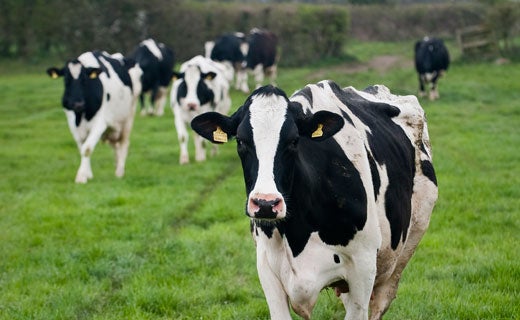By Danielle Kassatly, Genetics and Genomics, ’16
Author’s Note:
“This piece aspires to encourage consumers to critically interpret the scientific facts presented in everyday advertisements. Our society assumes that rBST and many other synthetic chemicals are detrimental to health, this essay emphasizes the importance of challenging fallacious argument in order to fairly evaluate the use of rBST.”
As the United States is becoming increasingly concerned with how food is produced and the effects of artificial substance addition, certain production methods are being scrutinized. In particular, methods of milk production in cows have been criticized for increased artificial hormone use and studied with seemingly inconclusive findings.
Notably, recombinant bovine somatotropin (rbST), a synthetic growth hormone used to increase milk production in cows, is a popular target of this scrutiny because of the concern that increased hormone consumption will interfere with human hormone chemical signaling. This rbST is almost identical to the naturally occurring growth hormone in cows, but its effects on cows are not yet ascertained.1
To illustrate, several countries have gone so far as to ban its use because of the unknown hormonal interaction it is thought to cause. RbST is associated with an increased risk of mastitis, an infection of a cow’s udder, which is commonly treated with antibiotics. From a study done on a sample of 1,128 cows collected from 28 different herds and 4 geographical regions, cows treated with rbST had a 23% increase in antibiotics use compared to untreated cows.1 This increase in antibiotic treatments caused scientists to question if rbST caused an increase in antibiotic residues in milk since rbST was introduced in 1994. The result of this study is alarming because over the past twenty years, more than 35 million cows were treated with rbST in the United States, and results of increased presence of antibiotics in milk has been linked to increased risk of breast, colon, and prostate cancer.3
Contrary to the results of milk quality in the antibiotic study, another way to test milk quality is to test somatic cell count (SCC), which is the number of white blood cells per milliliter of milk. SCC is a good indicator of cow health and milk quality because an increase in somatic cells is a response to pathogens. The legal maximum SCC count in the European Union, Canada, and Australia is 400,000 cells/mL, while the United States allows an SCC that is 87.5% higher, at 750,000 cells/mL. The USDA has shown a decrease in the average SCC in the United States from 1998 to 2009. This decrease in SCC shows that pathogens in the milk produced in the United States has gone down since 1998. Although this data seemingly supports that quality is associated with rbST, it is important to note that correlation alone is not enough to support that rbST was the factor that improved milk quality. Such improvement in milk quality since rbST’s introduction is very possibly a result of increased regulations and the implementation of new technology in milk production.1
Ultimately, the studies on the effects of rbST, taken together, are not fully conclusive, but might support that rbST growth hormone may be deleterious to human health by potentially increasing risk of breast, colon, and prostate cancer. In conclusion, there are many ways to test the quality of milk through somatic cell count in response to pathogens, and increase in antibiotics residue. Scientists much look at various results together to get a good understanding of rbST growth hormone’s risk on human health. The United States’ widespread use of rbST necessitates further research to determine the magnitude to which rbST’s increased risk of mastitis in cows affects cow health.
Sources:
Image Source: http://www.j-sainsbury.co.uk/media/latest-stories/2013/20130913-sainsburys-reviews-price-paid-to-british-dairy-farmers/
References:
- Gohary, K., Leblanc, S., Lissemore, K., Overton, M., Massow, M., & Duffield, T. (2014). Effect of prepartum administration of recombinant bovine somatotropin on health and performance of lactating dairy cows. Journal of Dairy Science, 6231-6241. Retrieved October 1, 2014.
- Collier, R., & Bauman, D. (2014). Update on human health concerns of recombinant bovine somatotropin use in dairy cows. Journal of Animal Science, 1800-1807. Retrieved September 30, 2014.
- “New Study Warns of Breast and Colon Cancer Risks from RBGH Milk.” New Study Warns of Breast and Colon Cancer Risks from RBGH Milk. N.p., n.d. Web.

